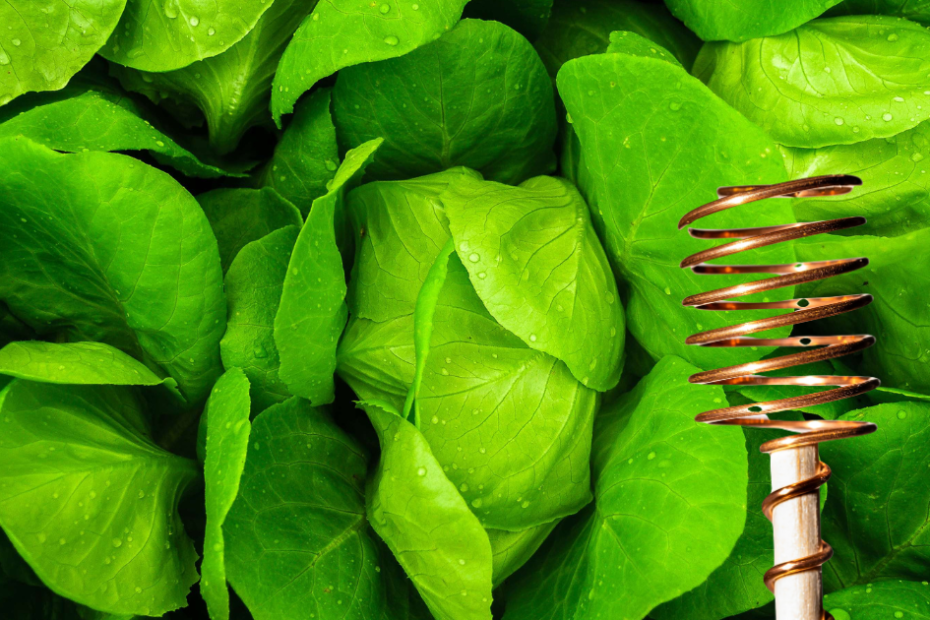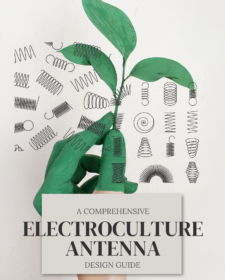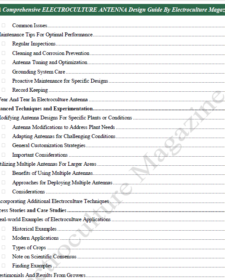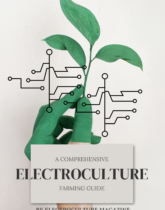Types of Electroculture is an innovative and environmentally friendly practice that utilizes natural energy sources like electromagnetic fields, atmospheric electricity, and specific materials to enhance plant growth. Rooted in over a century of experimentation, electroculture integrates science and nature to improve agricultural yields without the reliance on chemical fertilizers or pesticides. This method leverages the Earth’s abundant energy resources to create optimal growing conditions for plants, promoting healthier crops and sustainable agricultural practices.
At the heart of electroculture is the understanding that plants interact with various energy fields present in their environment. These energy fields, including weak electrical currents and magnetic forces, can directly influence plant metabolism, root development, and nutrient absorption. By channeling and optimizing these natural energies, electroculture provides an alternative approach to traditional farming practices, addressing challenges like soil depletion, declining biodiversity, and the overuse of synthetic inputs.
Electroculture methods are diverse, utilizing tools and techniques designed to capture and direct energy. Some systems employ simple materials like copper wires and coils to amplify the subtle electromagnetic forces in the soil. Others rely on atmospheric antennas to attract and convert free electrons into a source of energy that plants can absorb. Additionally, magnetic technologies are incorporated to condition water used for irrigation, improving overall crop hydration and vitality.
Far from being a one-size-fits-all solution, electroculture can be tailored to suit different crops, environments, and goals. Research and historical records have demonstrated remarkable results, including increased yields, faster germination rates, and enhanced resilience against pests and diseases. By tapping into untapped energy sources, electroculture holds the potential to revolutionize the future of farming.

The History and Origins of Electroculture
Electroculture, a method that utilizes electrical currents to enhance plant growth, has roots that trace back centuries. The concept gained traction in the 18th and 19th centuries as scientists began to explore the relationship between electricity and life processes. Early pioneers like Abbot Nollet, a French physicist, experimented with applying electricity to plants as early as the 1740s. His observations indicated that electrical stimulation could influence seed germination and plant development, sparking the curiosity of subsequent researchers.
The 19th century saw a marked increase in experimentation with electroculture. Around 1844, physicist Karl von Reichenbach conducted studies that highlighted the effects of electric and magnetic fields on plants. His work laid the foundation for further investigations, particularly during the Industrial Revolution, when advances in electrical technology inspired cross-disciplinary research. By the late 1800s, special devices designed to apply electrical energy to soil and crops started appearing in agricultural tests. Patents for such equipment began to emerge, showcasing the innovative spirit of the era.
One of the most notable figures in electroculture history was Justin Christofleau, a French inventor who dedicated much of his life to advancing this technique. In the early 20th century, Christofleau designed and patented electroculture solutions that integrated copper wiring and atmospheric electricity to improve soil fertility. His methods produced significant yields and demonstrated the practical application of this science.
Electroculture also saw prominence in the mid-20th century, particularly within Soviet agricultural experiments. Researchers aimed to harness electrical currents and electromagnetic waves for large-scale farming. This historical progression illustrates a consistent, global interest in exploring how electricity can benefit crop growth and sustainability. The field remains a niche, yet continuously evolving, area of agricultural science to this day.
Understanding the Science Behind Electroculture
Electroculture is an innovative and environmentally friendly method that utilizes electrical or magnetic fields to enhance plant growth, fertility, and resilience. The underlying principles are grounded in physics, biology, and chemistry, making it a multidisciplinary approach to agriculture. At its core, this technique leverages the interaction of atmospheric energy and electrical currents with soil and plant systems to stimulate natural biological processes.
One of the primary scientific concepts behind electroculture is the use of ionization. Electrical stimulation encourages the ionization of nutrients in the soil, making essential minerals like nitrogen, potassium, and magnesium more bioavailable to plant roots. This process can optimize nutrient absorption, leading to healthier and more robust crops. Additionally, weak electrical currents influence microbial activity in the soil, fostering the growth of beneficial bacteria that aid in decomposition and nutrient cycling.
The geomagnetic field also plays a significant role in electroculture. Studies have shown that plants are sensitive to Earth’s natural electromagnetic fields, which affect cellular processes and growth patterns. By amplifying or channeling these fields through electroculture techniques, such as antennas or magnets, farmers can potentially enhance photosynthesis rates and germination. This, in turn, accelerates plant development and increases yields.
Electrical stimulation can also help plants manage water more efficiently. When exposed to controlled currents, plants exhibit improved osmotic regulation, reducing water stress and enabling them to thrive even in suboptimal conditions. Furthermore, this approach has been associated with increased resistance to pests and diseases, as electrically charged environments can alter plant metabolisms, making them less appealing to harmful organisms.
The science of electroculture bridges natural forces and modern agricultural practices, offering a sustainable alternative to chemical-based interventions. By understanding its mechanisms, growers can adopt methods that align with ecosystem balance while fostering enhanced plant growth.
Benefits of Electroculture in Sustainable Agriculture
Electroculture offers a range of advantages that align with the principles of sustainable agriculture by enhancing plant growth while minimizing reliance on external inputs. Its integration into farming practices has shown potential to address key agricultural challenges in an environmentally friendly manner.
Enhanced Plant Growth and Productivity
Electroculture stimulates plant metabolism by improving cellular activity, leading to healthier plants with faster growth rates. Exposure to electromagnetic fields or low-level electrical currents enhances nutrient uptake from the soil, boosts photosynthesis, and strengthens plant structures. This results in increased agricultural yields, making it particularly beneficial for meeting the demands of a growing population.
Reduced Dependence on Chemical Inputs
By naturally promoting plant vigor, electroculture decreases the need for chemical fertilizers, pesticides, and herbicides. Farmers can achieve healthier crops with fewer artificial additives, reducing environmental contamination and supporting soil health. This approach fosters a more sustainable agricultural process by limiting chemical build-up in ecosystems and groundwater.
Improved Soil Health
Electroculture techniques encourage microbial activity and nutrient cycling within the soil. Electric stimulation can enhance the availability of essential elements such as nitrogen and potassium, making them more accessible to plants. Over time, this contributes to healthier, more fertile soils that are better suited for long-term farming.
Adaptability to Diverse Conditions
Electroculture applications can be tailored to various farming environments, including urban gardens, greenhouse systems, and large-scale agricultural operations. Its adaptability ensures that smallholder farmers and commercial enterprises alike can incorporate this technology into their practices without requiring extensive modifications.
Eco-Friendly and Energy-Efficient
Unlike other agricultural innovations, many electroculture methods rely on renewable resources for energy, such as solar panels or wind generators. This makes the technology both cost-effective and sustainable in the long run. Additionally, its minimal energy requirements lower carbon footprints compared to energy-intensive farming methods.
An Overview of the Seven Types of Electroculture Techniques
Electroculture encompasses various methods leveraging electricity, natural magnetic fields, and atmospheric energies to stimulate plant growth. These techniques are innovative yet rooted in historical practices, making them highly versatile for diverse agricultural applications.
- Magneto-Electroculture This method uses magnets or magnetic fields to enhance soil fertility and plant vitality. By arranging magnets strategically near plant roots or embedding them in the soil, practitioners aim to stimulate ion exchange and water molecule polarization, supporting nutrient uptake and cellular function.
- Atmospheric Energy Electroculture Atmospheric energy techniques harness natural energies, like static electricity or telluric currents, to boost plant development. Antennas, copper rods, or pyramids are often placed in fields to collect and transmit these energies to the soil and plants, promoting healthier agricultural ecosystems.
- Electrostatic Electroculture Electrostatic methods involve installing devices that emit low-level electrostatic charges around crops. These devices create a mild electric field that improves seed germination rates, enhances nutrient transportation, and potentially deters pests.
- Electromagnetic Induction Electroculture This technique focuses on applying electromagnetic fields to agricultural zones. Devices that produce alternating or direct currents energize the soil and improve the movement of ions, fostering microbial activity and plant nutrient absorption over time.
- Electrical Stimulation of Seeds Pre-planting seed treatment using electrical currents is a targeted approach to enhance germination and early growth. Seeds are exposed to brief, low-voltage currents, activating metabolic processes and increasing resilience against environmental stresses.
- Telluric Energy Techniques Telluric energy practices involve exploiting the Earth’s natural electromagnetic currents or geomagnetic forces. By aligning planting sites to these currents through conductive materials, plants may access enhanced energy flows, encouraging growth.
- Ionization Electroculture Ionization methods polarize surrounding air molecules, leading to improved air quality and nitrogen fixation. Devices such as ionizing bars or air-ion generators create charged particles beneficial for plants, optimizing photosynthesis and respiration efficiency.
Electroculture techniques offer diverse ways to amplify plant life processes naturally, aligning agricultural practices with Earth’s inherent energies.
Atmospheric Antennas: Capturing Energy from the Air
Atmospheric antennas, a fascinating aspect of electroculture, utilize conductive materials to harvest electrical energy directly from the atmosphere. These antennas act as pathways for naturally occurring electromagnetic fields and atmospheric ions, redirecting this energy into the soil to stimulate plant growth. By leveraging these naturally available resources, they offer a sustainable and innovative approach to enhancing agricultural productivity.
The antenna system typically includes a conductive rod or wire, often made of copper, aluminum, or other metals known for their high conductivity. This rod is elevated above the ground to maximize its exposure to atmospheric energy. It is then connected to a grounding system or directly into the soil, where the captured energy is dispersed. These setups are sometimes paired with diodes or resistors to regulate the flow of electricity and prevent overload.
Atmospheric antennas work by collecting the electrostatic and electromagnetic charges present in the air—charges that are naturally produced by solar radiation, lightning, and atmospheric movements. This energy not only enriches the soil but also enhances microbial activity, further promoting plant health. Research suggests this method may improve root development, increase nutrient uptake, and even boost resistance to pests and diseases in certain plants.
For optimal efficiency, positioning the antenna in windy or open areas helps ensure a steady energy flow. Attention must also be given to factors such as antenna height, material choice, and nearby structures, as these can influence its effectiveness. Careful placement and maintenance are critical for long-term success.
Atmospheric antennas present substantial potential for agricultural applications, particularly in regions with limited access to artificial fertilizers or electricity. This method aligns with principles of ecological balance, supporting sustainable farming without reliance on synthetic inputs.

Electromagnetic Circuits: Enhancing Soil Energy
Electromagnetic circuits play a pivotal role in electroculture by leveraging natural and artificial electromagnetic fields to stimulate soil vitality and plant growth. Unlike conventional agricultural techniques, which rely heavily on chemical interventions, these circuits harness subtle energy flows within the soil to energize roots and enhance nutrient absorption.
These systems incorporate conductive materials such as copper, aluminum, or carbon to generate electromagnetic fields. By inserting spirals, rods, or coils into the soil, these circuits create localized magnetic energy zones that influence ion movement in the ground. As ions flow more efficiently, plants experience improved access to essential elements like nitrogen, phosphorus, and potassium. This efficiency eliminates the dependency on synthetic fertilizers, making the practice both sustainable and environmentally friendly.
Electromagnetic circuits also boost microbial activity in the soil. Electromagnetic fields generate a low-level charge that promotes beneficial bacterial proliferation, leading to a healthier and more balanced microbial environment. Enhanced microbial activity assists in organic matter decomposition and ensures the steady formation of humus, which improves soil structure and water retention capabilities.
The application of electromagnetic circuits extends beyond plant nutrition. They can mitigate soil compaction, promote the release of dormant nutrients, and counteract the effects of electrostatic imbalances caused by over-farming. Farmers and gardeners can strategically position these circuits to align with Earth’s natural magnetic grids, amplifying overall energy dynamics.
By embracing this technique, electroculture practitioners foster a low-maintenance agricultural system that aligns with Earth’s natural rhythms. The approach not only reinvigorates soil ecosystems but also offers a renewable, chemical-free pathway to amplify crop resilience and yield.
Electrostatic Methods: Boosting Plant Vitality
Electrostatic methods represent a fascinating branch of electroculture, leveraging static electric charges to enhance plant growth and overall vitality. These methods involve applying controlled electrical charges to plants, soil, or the surrounding environment to stimulate biological processes. By manipulating the electrical fields around plants, electrostatic techniques can improve nutrient uptake, amplify photosynthesis, and potentially increase yields.
One way electrostatic energy is applied is through specialized devices that charge particles in the air. This is particularly useful in greenhouse environments, where the charged particles can interact with plant foliage to boost ion exchange. The enhanced ion exchange allows for increased absorption of nutrients like nitrogen and potassium, which are critical for plant development. Such methods have shown particular success in leafy vegetable crops, known for their rapid nutrient demand.
Additionally, soil systems benefit greatly from electrostatic applications. The electrical charges can help break down compacted soil particles, improving aeration and water infiltration rates. Enhanced root penetration becomes possible in such conditions, fostering stronger, deeper root systems. Furthermore, the increased microbial activity in charged soils can lead to the accelerated breakdown of organic matter, making crucial nutrients more bioavailable to plants.
Certain experiments with electrostatic fields have also demonstrated their ability to deter specific pests. The charges interfere with the navigation of airborne insects, potentially reducing pest damage without the need for chemical pesticides. This adds an ecological advantage to electrostatic methods, further aligning them with environmentally sustainable farming practices.
As with other electroculture techniques, these methods remain highly versatile. They can be integrated alongside traditional agricultural tools, offering farmers and gardeners a significant yet non-invasive way to boost plant vitality.
Magnetotherapy: Utilizing Magnetic Fields for Growth Stimulation
Magnetotherapy in plant cultivation involves exposing seeds, seedlings, or soil to magnetic fields to enhance physiological and biochemical processes. This innovative technique leverages the principles of magnetism to affect cellular activity and nutrient absorption in plants. Through controlled exposure, magnetic fields can influence the ion transport systems within cells, leading to improved metabolic activities and growth rates.
Plants subjected to magnetotherapy often exhibit increased germination rates and stronger root development. Magnetic fields stimulate enzyme activity and enhance water absorption, which contributes to healthier, more robust plants. Research has shown that the exposure can improve photosynthesis efficiency by optimizing chlorophyll production. This results in vibrant foliage and better overall plant resilience.
The application of this technique typically entails the use of either static or pulsed magnetic fields. Static magnetic fields utilize permanent magnets placed in the growing environment or near the seed bed. Pulsed magnetic fields, on the other hand, are generated by electromagnetic devices specifically designed for agricultural purposes. Both methods aim to optimize soil magnetism or directly encourage cellular responses in the plant structure.
Farmers and gardeners employing magnetotherapy usually integrate it with other natural growth techniques to amplify effects. For instance, seeds pretreated with magnetic fields often germinate faster, making them better candidates for hydroponics or soil-based cultivation systems.
Magnetotherapy is especially valued for its environmental sustainability since it eliminates the need for chemical fertilizers or growth stimulants. Furthermore, its ability to enhance plant immunity helps mitigate pest and disease-related damage. This combination of benefits makes it an appealing option for eco-conscious growers looking to maximize yield organically.
Bio-Electric Currents: Imitating Nature’s Electrical Patterns
Bio-electric currents refer to the subtle electrical signals that exist naturally in living organisms, including plants. These currents help regulate processes like nutrient absorption, growth, and stress responses. Electroculture techniques that mimic these natural electrical patterns aim to enhance plant growth by stimulating biological activity. This approach combines insights from biology, physics, and agriculture to create a living system where plants can thrive with minimal external inputs.
In nature, bio-electric signals are created by ion exchange across cellular membranes. This dynamic electrical activity plays a critical role in how plants respond to environmental stimuli, such as sunlight, soil quality, and moisture levels. Electroculture harnesses these principles by introducing low-level electrical currents in a deliberate and controlled manner. These currents are designed to mimic and amplify the natural electrical environment of plant cells and roots, effectively strengthening their biological processes.
Some methods employed for this purpose include:
- Copper and Zinc Nodes: Conductive materials like copper and zinc are placed in the soil to generate a mild electric current. The potential difference between metals helps replicate natural bio-electric conditions.
- Solar-Powered Electrodes: Solar panels are used to power electrodes that emit low-intensity electric pulses. These pulses are guided into targeted areas for maximum root zone stimulation.
- Ion Field Generators: Devices designed to create an electric field around plant beds, prompting electrical interactions similar to those found in natural ecosystems.
By integrating these methods, plants experience enhanced cell membrane performance, leading to more efficient nutrient uptake and faster growth. Controlled bio-electric stimulation can also improve resistance to pathogens and environmental stressors, further promoting vigorous health. This technique illustrates how closely observing and mimicking nature’s own blueprints can yield transformative results in agriculture. Transitioning from traditional farming to bio-inspired systems like this reflects a shift toward more sustainable and innovative growing practices.
Solar-Powered Electroculture: Integrating Sunlight and Electricity
Solar-powered electroculture merges renewable energy technology with agricultural innovation, leveraging sunlight to produce controlled electrical currents that enhance plant growth. By using solar panels as the energy source, this method eliminates dependency on traditional electricity grids, making it ideal for remote or off-grid agricultural operations. This approach offers a sustainable, eco-friendly solution for farmers seeking to optimize crop yields without increasing their carbon footprint.
In practice, the system typically involves installing photovoltaic panels to capture sunlight, converting it into electricity that powers electrodes or small devices positioned around or within plant beds. These electrodes deliver subtle, low-voltage electrical stimulation to the soil or plants, influencing processes such as nutrient absorption and root elongation. Enhanced electrical conductivity in the soil boosts microbial activity, potentially enriching the micro-ecosystem surrounding the plants.
The equipment setup can vary significantly based on the scale of operation. For small-scale farming, portable and compact solar arrays are sufficient. Large-scale systems may require arrays capable of storing excess energy in batteries, enabling round-the-clock operation. Such configurations ensure consistent electrical stimulation even during cloudy weather or at night.
Benefits of this method include its ability to operate sustainably without increasing electricity costs or causing environmental harm. By integrating clean energy with soil enhancement techniques, solar-powered electroculture achieves dual objectives of reducing energy consumption and improving agricultural productivity.
Transitioning to solar-driven practices further positions this technique as a solution aligned with modern environmental goals. It provides a pathway for achieving both economic and ecological efficiency while fostering innovation within the realm of sustainable agriculture.
Pulse-Electrical Stimulation: Optimizing Short Bursts of Electricity
Pulse-electrical stimulation involves the application of short, controlled bursts of electrical current to plants in order to enhance their physiological processes. Unlike continuous electrical exposure, this method employs intermittent pulses, which reduce the risk of overstimulation or damage to plant tissues. These electrical pulses are designed to mimic natural environmental stimuli that plants may experience, such as micro-currents generated by lightning or the electrical fields in the soil.
This technique focuses on optimizing the duration, intensity, and frequency of electrical pulses to maximize benefits. Research indicates that short bursts of electricity can enhance ion exchange within plant cells, leading to improved nutrient uptake and water absorption. Additionally, the stimulation appears to accelerate cellular signaling pathways, encouraging robust growth and potentially boosting plants’ resistance to environmental stressors.
The process typically involves the placement of electrodes near the plant roots, stems, or leaves. The positioning of the electrodes is critical, as it ensures precise delivery of the electrical pulses to the targeted areas. A timer or programmable device is often used to regulate the frequency and intensity of the stimulation. For optimal outcomes, adjustments need to account for variables such as plant species, growth stage, and environmental conditions.
Key advantages of pulse-electrical stimulation include improved crop yields, enhanced photosynthetic rates, and faster seed germination. This makes the technique particularly appealing to agricultural sectors seeking sustainable methods of boosting productivity. As pulse-based technology continues to evolve, studies are further investigating the potential of this method to enhance drought resistance and reduce dependency on synthetic fertilizers, aligning with eco-friendly agricultural practices.
Combining Traditional and Modern Techniques in Electroculture
Electroculture encompasses both traditional methodologies and modern advancements, bridging centuries of agricultural insight with contemporary innovation. Traditional electroculture relied heavily on basic principles, such as using natural electric currents in the Earth and enhancing soil quality. Early methods included the placement of copper wires, iron rods, or conductive materials in the ground to channel natural electromagnetic energy toward plant roots. These time-tested techniques often served as the foundation for improved nutrient absorption and growth stimulation.
Modern approaches have taken these early concepts into new realms of sophistication by incorporating advanced technology. Devices such as solar-powered circuits, magnetic coils, and even piezoelectric materials are now utilized to amplify the effects of naturally occurring electrical fields. Additionally, the use of frequency modulation and precision energy mapping allows for more tailored interventions, ensuring crops receive the optimal electro-stimulus for their specific requirements. These innovations have expanded electroculture’s potential, enabling it to meet the needs of large-scale farming operations and urban agricultural projects alike.
Combining these methods involves leveraging the slow-release benefits of traditional tools with the precision and efficiency offered by modern technologies. For example, systems that integrate copper pyramid structures with solar-driven magnetic resonators create a synergy between static and dynamic forms of electroculture. This hybrid approach not only maximizes plant growth but also encourages the sustainable use of both ancient practices and emerging technology.
Such integration highlights electroculture’s adaptability and versatility. By blending traditional and modern techniques, it empowers growers with scalable options while maintaining an ecologically sound footprint. When utilized effectively, this fusion complements diverse agricultural scenarios, from small gardens to commercial farms, proving that the coexistence of past wisdom and present advancements can yield remarkable results.
How to Implement Basic Electroculture Methods at Home
Electroculture, a tested method for enhancing plant growth using natural electrical fields, can be incorporated into home gardening with simplicity and minimal resources. Home growers can experiment with basic techniques to promote healthier plants and increase yields.
1. Creating a Simple Antenna
- A key starting point involves installing a copper or zinc rod into the soil near plants. This rod acts as an antenna to harness atmospheric energy.
- The recommended height for the rod is 3 to 6 feet, depending on the plant species and surrounding vegetation.
- To ensure proper conduction, bury the rod’s lower end at least 6 to 12 inches deep into moist soil and consider wrapping its upper end with a conductive material such as copper wire.
2. Using Magnetic Fields
- Repurposing magnets to stimulate soil can improve plant health. Home gardeners can use small neodymium or ceramic magnets placed near the plant’s base within the soil.
- Aligning the north pole of the magnet with the plant’s growth direction is thought to enhance natural energy flow.
3. Employing Electrodes
- To create a low-voltage electrode system, one can connect two wires: a positive and a negative charge, powered by a small solar panel or battery.
- Insert the wires into the soil on opposite sides of the plant to gently stimulate the roots. Care must be taken to use extremely low power, avoiding damage to the plants.
4. Enhancing with Atmospheric Energy
- Wind or weather vanes made of conductive metals, such as copper, can amplify natural atmospheric energies. These vanes should be placed close to vulnerable or slow-growing plants.
- Tie the vane’s base to an insulated wire and extend it into the soil for conductivity.
Testing these methods individually allows for observation of their effects on plant growth. Optimal results often depend on soil quality, climate, and plant type.
Electroculture in Large-Scale Farming Practices
Electroculture, a practice that harnesses electricity or magnetic fields to stimulate plant growth, is increasingly gaining attention in large-scale farming. Its potential lies in its ability to enhance yields, improve resource efficiency, and support sustainable agriculture, making it an appealing tool for modern farming operations seeking to balance productivity with environmental stewardship.
One of the key aspects of applying electroculture on a large scale is the integration of conductive infrastructure across extensive fields. This includes using metal antennas, conductive wires, or magnetic coils to create fields of weak electrical or magnetic energy that encourage soil ionization and stimulate plant metabolism. Such systems are designed to cover wide areas, and their implementation requires careful planning to optimize coverage and avoid electrical interference.
Large-scale farming operations often employ automated electroculture systems that rely on renewable energy sources like solar panels to reduce operational costs. This sustainable energy approach ensures that electroculture remains environmentally friendly while scaling to meet the demands of commercial agriculture. Additionally, these systems can integrate with existing irrigation and nutrient distribution setups, streamlining farm management processes.
Farmers utilizing electroculture on a larger scale report benefits such as faster germination rates, increased root mass, and greater crop uniformity. Crops like grains, legumes, and industrial vegetables commonly benefit from these enhanced growth cycles. Moreover, electroculture may reduce dependency on chemical fertilizers and pesticides by promoting natural soil health and plant vigor, minimizing input costs.
As with any agricultural technology, challenges arise in adopting electroculture for large-scale use. Farmers must consider initial setup costs, ongoing maintenance, and the variability in efficacy due to differing soil types or climatic conditions. Despite these hurdles, ongoing research and technological innovations are aiding in mitigating these concerns, paving the way for broader adoption of electroculture in the farming industry.
Scientific Studies and Experiments Supporting Electroculture
Scientific research on electroculture spans several decades, with experiments demonstrating its potential to stimulate plant growth, improve yield, and enhance soil fertility. Researchers have focused on how electromagnetic fields, electrical currents, and atmospheric energy influence plant biology and growth mechanics. Evidence from various studies highlights both emerging results and historical insights, underscoring the scientific credibility of electroculture techniques.
One significant study conducted by Dr. Selim Shaban at Zagazig University in Egypt explored the effects of electric fields on wheat seedlings. Results showed that exposure to specific frequencies improved germination rates, root elongation, and shoot biomass. Similarly, researchers at the University of Bologna in Italy studied tomato plants exposed to direct-current fields, reporting enhanced photosynthetic activity and nutrient uptake when moderate electrical charges were applied.
Historical experiments also provide valuable findings. In the early 20th century, physicist Justin Christofleau pioneered electroculture methods using antennas to capture atmospheric electricity. His experiments demonstrated noticeable increases in crop productivity with minimal soil amendments. The successful outcomes of these experiments eventually encouraged other researchers to adopt antenna-based models for modern crop science.
Studies have also reported beneficial electromagnetic effects on soil microbiology. Research from the Instituto Nacional de Tecnología Agropecuaria in Argentina revealed that weak electrical currents can stimulate microbial activity, which contributes to soil aeration and improved nutrient cycling. These findings suggest electroculture may support sustainable farming by enriching depleted soils without additional chemicals.
Future advancement in this field includes studies on the interaction of electroculture with other agro-technologies. Preliminary trials integrating electroculture with hydroponic systems have showcased promising results, hinting at practical applications in controlled-environment agriculture. These developments reflect an enduring curiosity about the relationship between electricity and natural growth processes.
Practical Tips for Maintaining Electroculture Equipment
Proper care and maintenance of electroculture equipment are essential to ensure its effectiveness and longevity. By following best practices, users can enhance the results of their electroculture systems while minimizing potential issues over time.
1. Regular Cleaning
Maintain cleanliness by periodically wiping down equipment with a damp, non-abrasive cloth to remove dirt, dust, and debris. For components that come into direct contact with soil or plants, such as copper wires or antennas, use a mild cleaning solution to prevent corrosion. Ensure all equipment is completely dry before reassembling or reactivating it.
2. Inspect for Wear and Tear
Conduct routine inspections to identify any visible damage, corrosion, or wear on the parts. Key areas to examine include connections, wires, and conductive materials. Replace any deteriorated or frayed parts to avoid compromising functionality or safety.
3. Monitor Electrical Connections
For systems involving batteries, solar panels, or other power sources, regularly check the connections to ensure they remain secure and free of rust or damage. Loose or corroded connections can interfere with proper operation and reduce efficiency.
4. Protect Equipment From Weather
Electroculture components placed outdoors may be vulnerable to harsh weather. Install protective enclosures or weatherproof coverings to shield delicate parts from rain, wind, and extreme temperatures. For portable devices, consider storing equipment indoors during off-seasons.
5. Calibrate and Test Performance
Occasionally test devices to ensure they generate the intended electromagnetic or electrostatic fields. Use diagnostic tools, if available, to measure output levels, verifying that systems are operating within desired parameters. Recalibrate as needed to maintain precision.
6. Prevent Oxidation
Copper and other conductive materials can oxidize over time, reducing their efficiency. Apply an anti-corrosion treatment or regularly polish such components to sustain optimal conductivity and performance.
7. Document Maintenance Cycles
Keep a log of all maintenance tasks, inspections, and replacement dates. This tracking system helps ensure periodic upkeep and provides a record of equipment performance, enabling users to address recurring issues promptly.
Adhering to these practices ensures that electroculture equipment performs reliably and supports robust plant growth in the long run.
Case Studies: Successful Applications of Electroculture Around the World
Electroculture techniques have been adopted globally, showcasing their potential to transform agricultural practices. From small-scale farms to large agricultural enterprises, these methods have delivered notable results, further validating their real-world applicability.
1. France: Electrostatic Wires Enhancing Vineyard Yield
In southern France, vineyard operators introduced low-voltage electrostatic wires suspended above grapevines to stimulate plant growth. Over a single growing season, they observed a significant improvement in grape yield and quality. This method reduced the need for chemical fertilizers, supporting the production of organic wine while decreasing operational costs. Data collected indicated a 20% increase in grape sugar concentration, crucial for premium wine production.
2. India: Magnetically Charged Water in Rice Fields
Farmers in Tamil Nadu experimented with magnetically charged irrigation water to support rice cultivation. The technique reportedly increased water absorption in soil and improved nutrient uptake by plants. Crop productivity rose by 18%, while water usage dropped noticeably. This innovation helped combat local water shortages and address soil salinity—a long-standing issue in the region.
3. United States: Copper Coil Experiments on Small Farms
In Wisconsin, small-scale vegetable farms used copper coils embedded in their soil to improve plant vitality. Crops such as tomatoes and cucumbers grew faster, with higher nutrient density and robust pest resistance. Farmers documented up to a 25% reduction in crop loss due to pests, coupled with a shorter growth cycle. The method also aligned well with sustainability goals since it required no synthetic inputs.
4. Australia: Atmospheric Antennae in Arid Lands
In Queensland, electroculture utilizing atmospheric antennae improved crop cultivation in arid regions. The antennae harnessed natural atmospheric electricity, stimulating soil microbes essential for plant health. Farmers noted significant success in growing drought-resistant crops like sorghum and millet, even with minimal rainfall. Increased microbial activity enriched the soil’s fertility, resulting in long-term sustainability for dryland agriculture.
These case studies underscore the diverse implementation of electroculture across different climates and crops, proving its versatility in adapting to unique agricultural challenges worldwide.
Debunking Myths and Misconceptions About Electroculture
Electroculture, while gaining attention for its potential to enhance plant growth, has not been without skepticism. A number of myths and misconceptions surround this practice, deterring some from exploring its benefits. Addressing these misunderstandings is essential for a balanced perspective.
One common myth is that electroculture involves unnatural or harmful practices. However, electroculture techniques leverage natural atmospheric energies, often relying on simple materials such as copper, zinc, or magnets to create beneficial effects. These methods do not introduce chemicals or synthetic compounds into the environment, making them eco-friendly alternatives to conventional agricultural practices.
Another misconception is that electroculture is a new or unproven method. In reality, its principles date back to the 18th and 19th centuries, with notable experiments conducted by scientists like Alexander Bain and Justin Christofleau. Historical evidence supports its effectiveness, although inconsistent documentation and a lack of contemporary awareness have contributed to doubts.
Critics sometimes argue that electroculture is pseudoscience with no scientific foundation. While the exact mechanisms remain a topic of ongoing study, there are credible scientific theories to explain the observed benefits, such as increased ionization and improved soil microbe activity. Empirical results, supported by case studies and field trials, underscore its potential.
There is also the belief that electroculture requires expensive or complex equipment. In fact, many techniques are straightforward and affordable to implement, such as using conductive materials to craft antennas or spirals, making the practice accessible even to small-scale gardeners.
By addressing these myths, individuals can better understand electroculture’s true potential and evaluate whether it complements their agricultural goals. Incorporating evidence-based insights fosters informed decision-making and helps dispel unwarranted doubts surrounding this innovative approach.
Challenges and Future Prospects in Electroculture Research
Electroculture research, though promising, encounters several challenges that impede its widespread adoption and understanding. One major issue is the lack of standardized methodologies across studies. Researchers employ varying techniques, electrode materials, and voltage levels, making it difficult to compare results or establish universally applicable protocols. This inconsistency hinders the ability to draw firm conclusions about the underlying mechanisms influencing plant growth.
Another challenge lies in understanding the biological processes affected by electrical stimulation. While studies suggest that electroculture can enhance nutrient uptake, photosynthesis, and root development, the exact cellular and molecular mechanisms remain unclear. This gap in knowledge limits progress and raises questions about potential long-term impacts on plant health and ecosystems. Additionally, skepticism about electroculture exists within the traditional agricultural community, as the scientific basis for the practice remains under scrutiny.
From a practical standpoint, the cost of implementing electroculture systems at a commercial scale is a significant hurdle. Farmers and agribusinesses may find the initial setup costs of electrodes, power systems, and monitoring equipment prohibitive, particularly in developing regions. Moreover, the environmental implications of using electricity in agriculture, such as energy consumption and potential interference with local fauna, require further assessment to align electroculture with sustainability goals.
Future prospects in electroculture research are promising and multifaceted. Innovations in renewable energy could make electroculture systems more sustainable and cost-effective. Advancements in nanotechnology and bioengineering may also allow researchers to develop highly efficient electrodes and devices tailored to specific crops. Collaboration between agronomists, engineers, and environmental scientists could address current knowledge gaps, fostering broader acceptance and integration of electroculture within agricultural systems.
Environmental Impact and Role in Reducing Chemical Dependence
Electroculture methods offer significant environmental benefits by minimizing the need for chemical fertilizers, pesticides, and other synthetic inputs traditionally used in agriculture. These sustainable techniques harness natural energy fields, reducing harmful runoff and soil contamination caused by excessive reliance on agrochemicals. By promoting healthier soil ecosystems, electroculture preserves biodiversity, aids in carbon sequestration, and supports the long-term sustainability of farmlands.
One key environmental advantage of electroculture is its ability to enhance nutrient uptake efficiency in plants without external chemical support. Devices such as antennas, copper coils, or magnetic setups interact with the Earth’s electromagnetic field, increasing the bioavailability of essential nutrients in the soil. This process reduces the dependency on synthetic fertilizers, which often contain nitrates and phosphates known to contribute to waterway pollution through leaching and agricultural runoff.
Additionally, specific electroculture practices, such as the use of charged magnetic fields or atmospheric energy collectors, effectively combat pests and diseases. Instead of relying on chemical pesticides, these energy manipulations create an unfavorable environment for harmful organisms while preserving beneficial insects and microorganisms. This shift aids in controlling pest populations without disrupting the ecological balance.
Electroculture also promotes healthier plant growth and higher crop yields by stimulating natural energy flows, encouraging plants to utilize resources more efficiently. This allows farmers and cultivators to maintain high productivity levels while decreasing their reliance on industrial inputs. As a result, agricultural systems adopting electroculture contribute to reduced greenhouse gas emissions associated with chemical production and application.
These techniques also align with organic and regenerative farming principles, fostering resilience in ecosystems. By offering a practical pathway to achieve chemical-free cultivation, electroculture represents an innovative solution to environmental challenges faced by modern agriculture. Its role continues to grow as global interest in sustainable farming practices intensifies.
Conclusion: Why Electroculture is a Game-Changer for Plant Growth
Electroculture represents a transformative approach to agriculture and gardening, demonstrating the potential to enhance plant health and productivity without the need for synthetic inputs. By leveraging the natural principles of electromagnetic energy, it harmonizes with plants’ intrinsic growth mechanisms. This innovative method increases nutrient absorption efficiency, improves soil health, and reduces reliance on chemical fertilizers, offering a sustainable solution for enhanced crop yields.
One of the most compelling features of electroculture is its ability to positively influence root development. Techniques such as antenna-based atmospheric energy harnessing or magnetic treatments stimulate cellular processes in plants, ensuring stronger, more resilient root systems. This enhanced vigor allows plants to access water and nutrients more efficiently, even in challenging environmental conditions.
Electroculture also improves environmental adaptability in plants. By fostering an ideal balance of electrical and magnetic energies, plants can develop resistance to extreme stresses, such as drought, temperature fluctuations, or pest attacks. The enhanced growth capacity observed in electroculture-based cultivation has been particularly appealing for farmers seeking sustainable methods to combat climate variability.
Another key advantage lies in its cost-effectiveness and simplicity. Unlike chemical-enhanced agriculture, which often leads to diminishing returns in soil fertility, electroculture employs natural phenomena that require minimal maintenance and resources. This ensures long-term sustainability while reducing the environmental footprint of agricultural practices.
The potential applications of this technology extend to urban gardening as well as large-scale farming, making it appeal to diverse agricultural sectors. With the push for eco-friendly food production, electroculture is emerging as an instrumental tool for meeting global food security challenges while maintaining ecological balance. Its innovative, non-invasive nature positions it as an integral component of future agricultural practices.


























